Please Note: Firefox and some other search engines are not suitable
– Use “Internet Explorer” for this page to load perfectly!
Click the logo above to reach
the ssMaritime FrontPage for News Updates & “Ship of the Month”
With Reuben
Goossens
Maritime Historian, Cruise‘n’Ship
Reviewer, Author & Maritime Lecturer
Please Note: All
ssMaritime and other related maritime/cruise sites are 100% non-commercial and
privately owned. Be assured that I am NOT associated with any shipping or
cruise companies or any travel/cruise agencies or any other organisations!
Although the author has been in the passenger shipping industry since 1960,
although is now retired but having completed around 680 Classic Liners and
Cargo-Passengers Ships features I trust these will continue to provide classic ship
enthusiasts the information the are seeking, but above all a great deal of
pleasure!
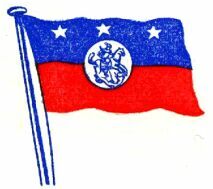
Cogedar Lines
MS Flaminia
Page Two - A Migration
Story
A Young
man escapes the Holocaust in
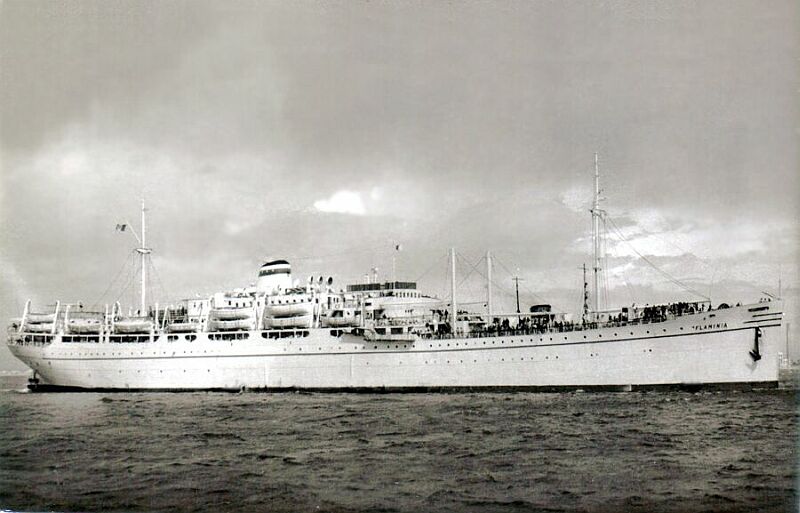
MS
Flaminia seen in the mid 1950’s
So, when the chaos that followed the 1956
revolution gave me the opportunity to escape, I grabbed it by 2 hands. I
crossed into
Around half of the ship was filled with
passengers were immigrants from
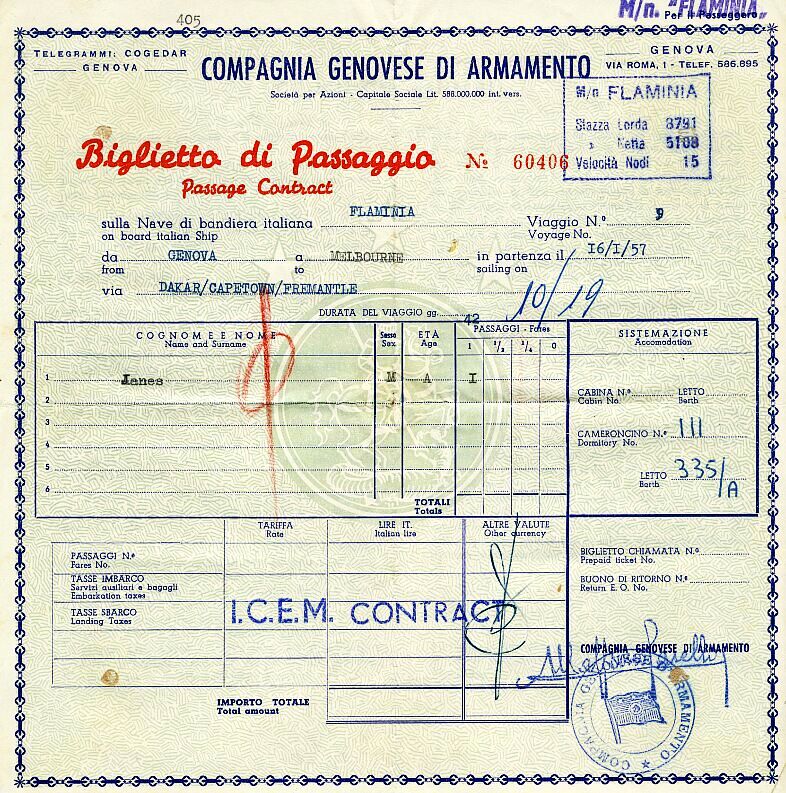
Accommodation for me was in a dormitory, having bunk beds (berths). There must have been about 25 or 30 men in the room. Toilet and shower facilities were shared. The ship could not have sufficient size fresh water tanks as on the longer legs of the journey, on 2 occasions, they supplied sea water to the showers. Cabins were given to families. They were nothing like the cabins on today’s modern cruiser ships. For they also had share bathrooms. But then again, this was a migrant ship and not a luxury liner! My ticket was arranged by an UN organisation, called I.C.E.M., as we were considered as refugees, whist the Italians sailed on what was called the “Australian Italian Assisted Passage Scheme.”
However, I was impressed with the quality of food, for at every meal, there was fresh bread rolls on the table and a carafe (or 2) of nice wine. Although I never drank very much, but believe me, there were plenty of people to drank my share and more! The carafe has never gone back with any wine left in it.
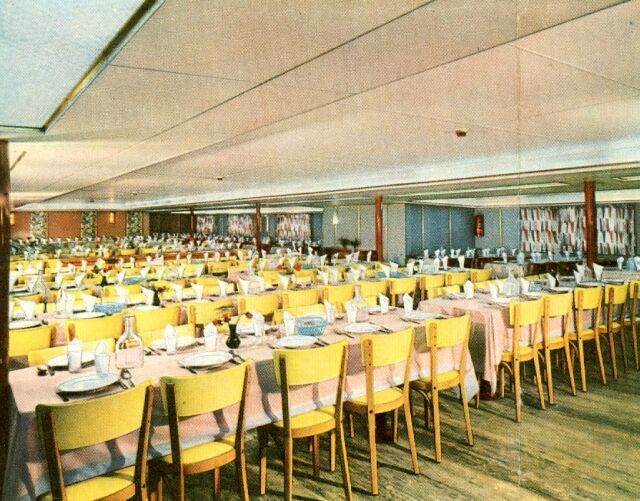
As the Suez Canal was closed at the time, the
Flaminia went around the West coast of Africa and our first port of call was
The next port was
We departed
During the voyage and being a young boy, my mind was on girls almost all of the time. There were very few Hungarian girls of my age and 5 or 10 times as many males. It was an impossible situation. There were more Sicilian girls on board, but their parents were very vigilant. Probably their religious believes prevented them to allow their daughter to have a boyfriend. I couldn’t speak Italian anyway, so this was impossibility. My memory of the trip was boredom. There were the occasional functions organised by the crew, but again it was in Italian. There was a lot of celebration crossing the equator. We had King Neptune celebration, plus binoculars with a hair across the lenses. When you looked into them, you could see the equator!
I have to say, Fremantle was a bit of a surprise. I have never seen balconies or awnings overhanging and supported by posts, placed near the edge of the footpath. I have only seen this in Western (Cowboy) movies! The tramlines ran on elevated blue metal tracks, much like the railways. I was used to tramlines sunk into the road surface. My other observation was the weather. It was February, and it was very hot and humid. In the other hand, I fund the people very friendly and helpful.
As the engine problems continued and could not
be repaired in time, eventually, it was decided to send us all by train to the
Eastern States. On the platform at
The train took us to Bonegilla Migrant Camp,
which took about 3 days and 3 train changes due to different railway gages. I
really enjoyed the train trip as I got to see a lot of the country side. The
camp was located on the banks of the Murray River near the Towns of Albury and Wodonga
on the border of
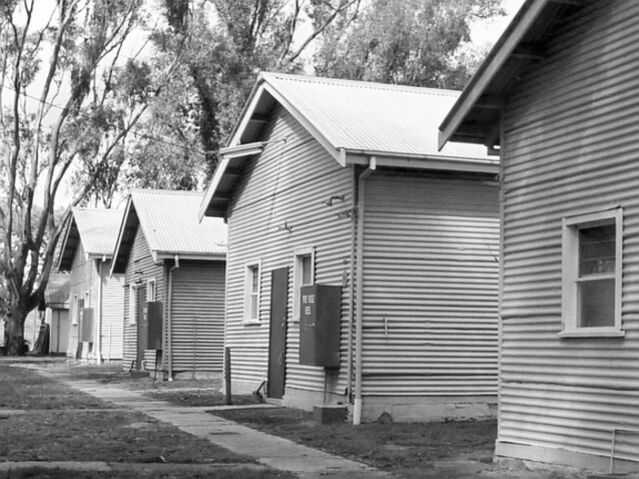
They were Nissan huts, but as an 18+ year old,
I was quite satisfied. I had a clean comfortable room and plenty of good food,
etc. They made me feel welcome. We were free to come and go and things like
security were unheard of in those days. I think I stayed there for 3 days,
before I was given a train ticket to
Every day I think about immigration, I thank God, that I chose this country. Those people who criticise us, don’t know, how lucky they are to be here.”
This story was sent to ssMaritime by Janes and I am most grateful to him sending it and for its content, as it
provides a very special insight of his voyage and experience during of that
part of his life. And I am so happy to know that a good new life was found for
him in this fine country of
Reuben Goossens.
Page One: MS Flaminia History Page
Page Two: A
Holocaust Survivor sails to Australia
Page Three: Lifelong
friends sail to Australia in 1958
Page Four: Ingolf Schreiber’s Voyage in 1960
Also visit:
“Blue
Water Liners sailing to the distant shores.
I watched them come, I watched them go and I watched them die.”
****************************
Visit our ssMaritime
Main INDEX
Where you will discover around 680 Classic Passenger
& Passenger-Cargo Liners!
ssMaritime.com & ssMaritime.net
Where the ships of the past make history & the 1914 built MV Doulos Story
Please Note: ssmaritime
and associated sites are 100% non-commercial and the author does not seek
funding or favours and never have and never will.
Photographs on ssmaritime and associate pages are either by the author or from the author’s
private collection. In addition there are some images and photographs that have
been provided by Shipping Companies or private photographers or collectors.
Credit is given to all contributors, however, there are some photographs
provided to me without details regarding the photographer or owner concerned.
Therefore, I hereby invite if owners of these images would be so kind to make
them-selves known to me (my email address can be found at the bottom of the
page on www.ssmaritime.com), in order
that due credit may be given.
ssMaritime is owned & © Copyright by Reuben Goossens - All Rights Reserved
